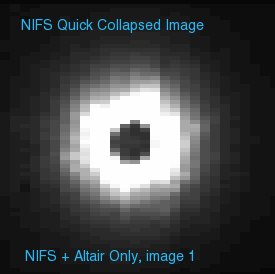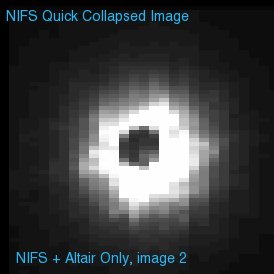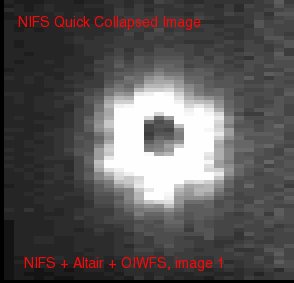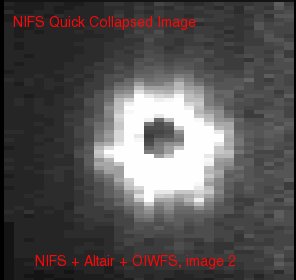
| You are in: Instruments > NIFS > Performance and Use > Components > OIWFS |
 |
Guiding with NIFS: Possible Guide Star Configurations |
During NIFS commissioning in October and November 2005, observations with several guide star configurations were tested. The overall results can be combined into the two general guiding scenarios described below: (1) NIFS observations fed by adaptive optics and (2) non-AO NIFS observations.
(a) NIFS+Altair IFU Spectroscopy:
Observations made with NIFS+Altair adaptive optics will likely be the most common observing mode. Typically, the adaptive optics correction with Altair on a bright star give best-fit FWHM values of 90 - 110 mas. The FWHM is limited by the rectangular 0."1 x 0."04 pixels in the NIFS spectrograph, so the Altair PSF is sub-sampled by the NIFS spectral pixels. We found that guiding with NIFS+Altair yields correction results that are largely consistent with the performance described on the Altair Performance Webpage.
An upgrade to the Altair adaptive optics system during the Fall 2005 has made available a Field Lens for Altair AO observations. The field lens will allow for a more uniform Strehl ratio across the Altair guide field under suitable atmospheric conditions. The above webpage describing the field lens includes information about the pros and cons of using it for Altair-fed NIFS observations. For general observations (that do not use an OIWFS star), the field lens would probably be useful for NIFS+Altair spectroscopy for projects which seek to use guide stars that are more than 5" off-axis.
NIFS+Altair Available Options: NIFS+Altair observations are possible with or without the Altair field lens using on/off axis guide stars.
Guide Star Characteristics: For NIFS+Altair observations, all guide stars should be defined within ~25" of the science target object. For observations with the Field Lens, the AO guide region is only 30" - the lens vignettes all regions beyond this. See the Altair Performance Webpage for detailed on the guide performance vs. stellar magnitude for wavefront sensor stars. Also, the NIFS OT Help Webpage has information on the guide fields and configurations for NIFS+Altair stars.
(b) NIFS+Altair+OIWFS IFU Spectroscopy:
For each new instrument that is used with Altair, an extensive model is generated at a range of elevations and rotator angles to remove the flexure between the Telescope-Altair-Instrument system. While this model is very good at removing the vast majority of the system flexure, it is not perfect. The accuracy of the flexure compensation depends upon the deviation of the model from the true flexure for a given elevation and position of the rotator. Hence, some elevations/rotator positions have very accurate flexure compensation, while others deviate from the model. The typical flexure residuals for the NIFS+Altair flexure model are small, ~0."10 to 0."15 RMS. However, when observing for long exposure sets for NIFS frames it is desirable to remove as much of the residual flexure as possible.
The NIFS instrument is equipped with an infrared On-Instrument Wavefront Sensor (OIWFS). Historically, the infrared OIWFSs were supposed to provide fast tip/tilt guiding in sky regions that did not have a suitable optical wavefront sensor star for PWFS1 or PWFS2. However, unlike these scenarios for the NIRI and GNIRS OIWFSs, the NIFS OIWFS has been commissioned to be used solely in conjunction with Altair adaptive optics and will only be used to provide slow flexure corrections. Thus, the NIFS OIWFS can be used to remove as much of the residual 0."10-0."15 from the NIFS+Altair flexure model as possible. This allows for longer on-source observations of a science target with little residual flexure movement of the object. The performance of the NIFS+Altair+OIWFS system has proven to be especially useful when taking observations with a bright star centered behind an occulting disk (see below figures).
| The benefits of using an OIWFS star - Less Flexure movement of target | |

|

|
| Altair Only: NIFS + Altair Observation with the 0."5 occulting disk, first image after acquisition is shown on the left. NIFS + Altair Occulting Disk Observation, image 2 (on right) taken 30 minutes later, showing ~60mas of flexure movement since the beginning of the observation set. | |

|

|
| Altair+OIWFS: NIFS + Altair + OIWFS Observation with the 0."5 occulting disk, first image after acquisition is shown on the left. On the right, an image taken 30 minutes later is shown. The Altair+OIWFS guide configuration has resulted in very little flexure of the star behind the occulting disk during the observation set. | |
An OIWFS star should be used when:
When an OIWFS star is available within 30" of the science target, using the OIWFS star + the Altair field lens will improve the flexure correction performance.
And an OIWFS star should NOT be used:
NIFS+Altair+OIWFS Available Options: NIFS+Altair+OIWFS observations are possible with or without the Altair field lens using on/off axis guide stars.
Guide Star Characteristics: For NIFS+Altair+OIWFS observations, Altair all guide stars should be defined within ~25" of the science target object. The OIWFS guide star must be defined outside of the region vignetted by the NIFS pickoff probe, but inside of ~48" for good flexure correction. For observations with the Field Lens, the OIWFS guide field is only 30" in extent because the lens does not pass any light beyond a 30" radius. All OIWFS stars should be brighter than 14.5 magnitude in the K-band (for perfect weather conditions). The NIFS OT Help Webpage has detailed information on the guide fields and configurations for NIFS+Altair+OIWFS stars.
In addition to the Adaptive optics fed mode, NIFS has also been commissioned to be used with the Peripheral Wavefront Sensor, PWFS2. In optimal conditions, PWFS2 guide stars with magnitudes brighter than R~14.5 may be used to provide guide corrections for non-AO NIFS observations. The NIFS field will be vignetted for PWFS2 stars that are closer to the science target than ~3.8 arcminutes. The outer radius for appropriate PWFS2 guide stars is 7 arcminutes, so these two radii define the annulus for available guide stars for NIFS+PWFS2 observations. More information on the Peripheral Wavefront Sensor vignetting regions and information on how to define PWFS2 guide stars can be found in the OT help pages .
Extensive flexure modeling of the NIFS+PWFS2 system has not been done, but we presume that guiding with NIFS in this mode will provide performance similar to the NIRI+PWFS2 observations (roughly 0.1" of flexure per 30-45 minutes of on-sky observations, depending on the elevation and rotator position). It is not presently possible to use NIFS OIWFS guide stars to compensate for flexure when observing with PWFS2.
Last update January 2003; Tracy Beck